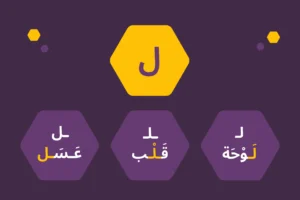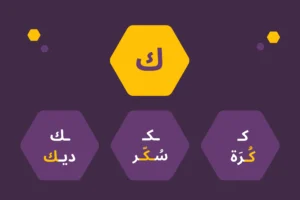What Are Arabic Tongue Twisters?
Arabic tongue twisters are short phrases or sentences that are difficult to pronounce quickly and correctly because they contain similar or repeating sounds.
Practicing Arabic tongue twisters is one of the most interesting ways to improve pronunciation. They have real educational and linguistic value and not just fun word games.
How Tongue Twisters Help Improve Arabic Pronunciation
Tongue twisters can help you articulate sounds clearly and practice difficult sound combinations in every language, not only Arabic. Repeating them strengthens the speech muscles and improves control of the tongue and lips.
An example from the English language is “She sells seashells by the seashore,” which improves the /ʃ/ (“sh”) sound.
Some of the common Arabic sound challenges are (ع ʿAyn,( ض)Ḍād,( ح)Ḥā,( خ)Khā, etc.)
Tongue twisters enhance fluency and speech speed. They train you to speak quickly and smoothly without losing accuracy, which can boost confidence. This is good for language learners and public speakers. Learners also become more aware of sound patterns, stress, and intonation, which sharpens their listening sensitivity.
Tip
Did you know that tongue twisters are really helpful as a warm-up for actors, singers, and presenters? Professionals often use tongue twisters to warm up their voices before performances or speeches, which helps them produce clearer, stronger speeches.
7 Fun Arabic Tongue Twisters
Let’s look now at some of the most common tongue twisters in Arabic:
Līrah wara līrah - ليرة ورا ليرة
English Translation
Pronunciation
Arabic Tongue Twister
coin after coin
Līrah wara līrah
ليرة ورا ليرة
This phrase is used playfully to describe saving or stacking money bit by bit.
The alternation between ل and ر (L and rolled R) is one of the most challenging transitions in Arabic pronunciation.
These two sounds are made close together in the mouth, but require different tongue movements.
Khayṭ ḥarīr ʻalā ḥīṭ Khalīl - خيط حرير على حيط خليل
English Translation
Pronunciation
Arabic Tongue Twister
A silk thread on Khalil’s wall.
Khayṭ ḥarīr ʻalā ḥīṭ Khalīl
خيط حرير على حيط خليل
We have similar-sounding consonants: خ (kh), ح (ḥ), and حـيط / خـليل require deep throat control.
The repetition of “ḥ” and “kh” sounds comes from the back of the mouth, but in slightly different places.
Taraqtu al-bāba … - طرقتُ البابَ
English Translation
Pronunciation
Arabic Tongue Twister
I knocked on the door until my arm grew weary,
And when she spoke to me, her words wearied me too.
She said, “O Isma‘il, be patient.”
I replied “O Asma, my patience is gone.”said, ‘O Asma, my patience has worn thin.’”
Taraqtu al-bāba ḥattā kalla matnī, falammā kallamatnī kalla matnī, qālat: yā Ismāʻīlu ṣabran, qultu: yā Asmā ʻīla ṣabrī.
طرقتُ البابَ حتى كلَّ متني، فلما كلَّمتني كلَّ متني، قالت: يا إسماعيلُ صبراً، قلتُ: يا أَسما عيلَ صبري
This is a classical-style tongue twister and mini-rhyme built on repetition and wordplay, but it has different meanings.
- kalla matnī appears twice, but the meaning shifts: the first kalla matnī means my shoulder got tired (from knocking too much). While the second kallamatnī means she spoke to me.
- yā Ismāʻīlu ṣabran / yā Asmā ʻīla ṣabrī
The first one “yā Ismāʻīlu ṣabran” means ‘oh Isma‘il, be patient.’ But the second one, yā Asmā is calling out to a woman called Asmā, while “ʻīla ṣabrī” means my patience has worn thin.
Dajājat jārinā ʻalā jdār dārnā - دجاجة جارنا على جدار دارنا
English Translation
Pronunciation
Arabic Tongue Twister
Our neighbor’s chicken is on our house’s wall.
Dajājat jārnā ʻalā jidār dārnā
دجاجة جارنا على جدار دارنا
This Arabic tongue twister is funny but tricky because of the repetitive /j/ and /d/ sounds.
The two sounds ج (j) and د (d) are front sounds but require careful pronunciation.
The word Dajājat has double ج (jj), and should be pronounced clearly.
We also have the letter ر (r), which appears multiple times in jārnā and dārnā.
So, rapid alternation between ج and ر can trip the tongue.
Man manna min mannin - من منَّ من منٍّ
English Translation
Pronunciation
Arabic Tongue Twister
He who bestows favors from God’s favour, the Gracious (God) bestows to him.
Man manna min mannin munna mina al-mannān
من منَّ من منٍّ مُنَّ مِنَ المَنَّانِ
This phrase is based on a Quranic style of phrasing. It is rich in nasal /m/ and /n/ and requires a repetition of similar sounds: m, n, a in different orders.
Arnabunā fī manwār Anwar - أرنبنا في منور أنور
English Translation
Pronunciation
Arabic Tongue Twister
Our rabbit is in Anwar’s skylight, and Anwar’s rabbit is in our skylight.
Arnabunā fī manwār Anwar wa-arnabu Anwar fī manwārina
أرنبنا في منور أنور وأرنب أنور في منورنا
This is a classic Arabic tongue twister with mirrored structure.
We have to repeat similar sounds: ar, an, n, w, your tongue has to move quickly between “our rabbit” and “Anwar’s rabbit.”
Ṭabaq ṭabaqnā - طبق طبقنا
English Translation
Pronunciation
Arabic Tongue Twister
The plate of our dish landed on your dish’s plate; can your dish’s plate land on ours?
Ṭabaq ṭabaqnā ṭabaqa ʻalā ṭabaq ṭabaqikum yaqdir ṭabaq ṭabaqikum yuṭbaq ʻalā ṭabaqnā
طبق طبقنا طبق على طبق طبقكم يقدر طبق طبقكم يطبق على طبقنا
The letters we are focusing on are ط (ṭ), which is an emphatic “t”, the sound ب (b), and ق (q), which is a deep back-of-throat “q”, and the repetition of the word “طبق” is easy to get mixed up. It is a fun challenge even for native speakers.
Tips to Practice Arabic Pronunciation Using Tongue Twisters
Practicing tongue twisters in Arabic can be fun, but challenging sometimes. You can start slow, then increase your speed gradually. Another helpful way is to record yourself saying the tongue twister so you can recognize progress and focus on challenging letters in Arabic, like ع (ʿayn), غ (ghayn), ض (ḍād), and ط (ṭāʼ).
Practice is key when it comes to pronunciation, so make sure you practice daily, around 5 to 10 minutes.
And to get the practice you need for all Arabic skills, not just pronunciation, check the AlifBee App. It can offer you pronunciation tools and speaking lessons, from Arabic letters to words and sentences.
Final word
Now you know 7 of the most common and fun tongue twisters in Arabic that you can use to practice and improve your Arabic pronunciation.
You can also challenge yourself and your Arabic pals with them.
Like any language, you might face challenging phases, but we always have a way to make things easy and fun with the AlifBee App, which you can download today to get a free14-day trial.
You can also check other challenging Arabic letters explained in detail, like the letter ر Raa’, the letter ط Taa’, or The 7 Heavy Letters in Arabic.









